Auricon 16mm
The Bach Auricon pro-600 is an academy aperture 16mm camera that runs at a sync 24 frames per second. It has a couple of options for a parallel view finder and an option for a 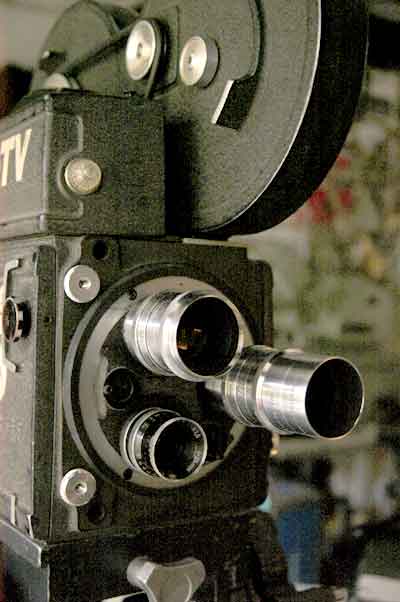 "through the lens" fine focus viewer. It has a reliable movement and 400' magazine. It runs very quiet making it's sound recording options very useable. Originally these cameras were equipped with optical track sound recording, but later the cameras were fitted or retrofitted with magnetic stripe sound recording equipment. Magnetic stripped film is no longer available but the older optical sound option can be used for an interesting effect. The sound quality of an in-camera optical recorder is poor, compared to modern digital standards, but it's unique character has a certain smoothness that is unlike other sound recording mediums. Best of all prints made from camera negatives or reversal stocks can be projected with location sound. If prints are to be made make sure that a super16 aperture and gate are used on the printer, this is necessary to expose the optical track which is at the far edge of the film. Also only single perf films can be used for the negative or the print. Pictured here is an Auricon Pro-600 mounted on a Worrall Geared Head which is in turn mounted on a Fearless Panaoram Dolly . The camera is using an Auricon NR amplifier for sound (pictured in the wooden case on the turret deck of the dolly. The camera also has an Lomo anamorphic lens adapter in front of it's Som Berthiot zoom lens/with reflex (dog leg) viewfinder.
"through the lens" fine focus viewer. It has a reliable movement and 400' magazine. It runs very quiet making it's sound recording options very useable. Originally these cameras were equipped with optical track sound recording, but later the cameras were fitted or retrofitted with magnetic stripe sound recording equipment. Magnetic stripped film is no longer available but the older optical sound option can be used for an interesting effect. The sound quality of an in-camera optical recorder is poor, compared to modern digital standards, but it's unique character has a certain smoothness that is unlike other sound recording mediums. Best of all prints made from camera negatives or reversal stocks can be projected with location sound. If prints are to be made make sure that a super16 aperture and gate are used on the printer, this is necessary to expose the optical track which is at the far edge of the film. Also only single perf films can be used for the negative or the print. Pictured here is an Auricon Pro-600 mounted on a Worrall Geared Head which is in turn mounted on a Fearless Panaoram Dolly . The camera is using an Auricon NR amplifier for sound (pictured in the wooden case on the turret deck of the dolly. The camera also has an Lomo anamorphic lens adapter in front of it's Som Berthiot zoom lens/with reflex (dog leg) viewfinder.
Jack has done it again...
Here is a short film shot by Jack Honeycutt
Click here for the windows media file
Here are some details in Jacks own words:
"It was shot using my NR 25-S7, and my Pro 600 Special, using a 400' load of K40. The mic
was the standard E6 Auricon mic. The microphone was sitting on the park bench between myself
and the woman I was talking with.
We (Wade & I were shooting film together that day) were on batteries. And I am not talking about the batteries for the amp. We were using a Auricon PS-21-AL portable power supply which was hooked up to a 12 volt aircraft battery to power up the 600.
As I remember it (Wade, jump in here) it was the end of the day and the 12 v. battery was running low. Wade had to watch the level meter in the NR 25, shoot film, focus, and at the same time keep turning a knob on the PS 21. The PS 21-AL has a knob called the Frequency Control. It moves a pointer in a display. As the battery weekend, he had to keep tweaking the knob to keep the pointer at the 60 cycle marker. He really needed 6 hands and three sets of eyes. I have no idea how he managed. All I did was talk to the women. Wade did all the work.
When the film came back, my voice and the woman's voice sounded a tad bit like mickey mouse. I can tell, but maybe folks listening to the clip can not, but listen for it. This is because of the low battery...
...The film was actually shot in McMinnville Oregon at the yearly UFO festival:
http://www.hotelore gon.com/ufofest0 7/index.php
The woman I was talking to had entered her dog in the UFO pet contest. I never found out if the dog won or not.
As an aside, Wade & I were packing:
1) Pro 600
2) Auricon wood tripod
3) PS21AL + battery box
4) NR25 amp + big black box of dry cells
5) box of pre loaded 400' magazines of film, and extra crap you might need at a remote shoot like a light meter, duct tape, etc.
We would set up, shoot, break down, run, set up, shoot, break down, run again. I think all camera men in the 1940s must have had 6 pack abs and look like Tarzan. It was well over 100 lbs of stuff.
The Sound Track Exposure setting number Wade & I came up with for K40 was 15.5 to 16. Right after we came up with this number Kodak announced it was going to drop this stock. To our friends in the EU countries where you can still get K40 or something similar (like that Chrome 40T at Wittner in Germany) I recommend you start with this setting and see how it works for you."
All of this is due to http://movies.groups.yahoo.com/group/Auricon_Sound/
Here is an Auricon operation demonstration video:
The video was intended to be a informative guide on use of a pro-600 with optical sound, however the video is not finished and since it has been months since anything has been done with it it seemed logical that it get posted in it's unfinished form than not at all. Enjoy.
The Auricon movement is well known to be very steady and reliable. So much so, that Cinema Products designed there very successful cameras the CP-16 and the CP-16R around the Auricon movement. In fact many of the CP cameras have parts inside that still say Bach Auricon. For example the camera used to shoot the sound sequences of this film:
http://owyheesound.com/idaho_city_100_2007.php
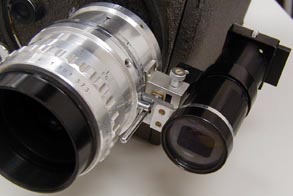 were shot with a CP-16R. To really describe a CP-16R start with a Auricon Pro-600. Then replace the AC sync motor with a DC crystal sync motor. Then add battery holder to the side of the camera. Next remove the shutter and replace it with a mirrored shutter set at a 45degree angle to allow for reflex viewing. Finally add a bayonet lens mount and a rotatable viewfinder (that has a through the lens light meter and beam splitter ready for a video tap) and you have a CP-16R. There are a few other things like a slimed down body rebuild and a fancy handle with a start stop button and a shoulder mount (the whole camera can be easily hand held to create great shots) but really the CP16R is just a really tricked out Auricon camera!
were shot with a CP-16R. To really describe a CP-16R start with a Auricon Pro-600. Then replace the AC sync motor with a DC crystal sync motor. Then add battery holder to the side of the camera. Next remove the shutter and replace it with a mirrored shutter set at a 45degree angle to allow for reflex viewing. Finally add a bayonet lens mount and a rotatable viewfinder (that has a through the lens light meter and beam splitter ready for a video tap) and you have a CP-16R. There are a few other things like a slimed down body rebuild and a fancy handle with a start stop button and a shoulder mount (the whole camera can be easily hand held to create great shots) but really the CP16R is just a really tricked out Auricon camera!
Be sure to check out Jack Honeycutt's Auricon Sound yahoo usergroup . There is a growing community of Auricon enthusiasts who are sharing information there.
http://movies.groups.yahoo.com/group/Auricon_Sound/
Read on for a link to an Auricon Sound on Film short that Jack shot...
- Click Here to view Michael Carter's
March 5th, 2002 Auricon test. This is a high resolution clip of the one found on Youtube.
Michael also was kind enough to give a detailed description of the filming/recording process. Here it is:
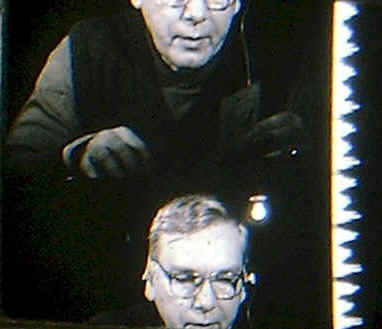 March 5, 2002 TEST 03.
March 5, 2002 TEST 03.
One roll of Plus-X Reversal was shot last night. Melita pushed the on button for me. I sat and read from the Wall Street Journal. The high range was used for the sound lamp. Settings were from 8 - 18. After reading 10 lines of copy, I changed the sound lamp two settings: 8, 10, 12, 14, 16, and 18. There is a short in the battery check and sound lamp switch. Jiggle it to get the 18 + lamp setting.
Two 650 W spot light lamps were set up each on a tripod. Filming was at night. Only the Tungsten bulbs were on and not the fluorescent lights. The light reading off a gray card was between 25 and 50. The Weston 715 light meter was used. That gave a setting of between f 5.6 and f 8 (f 6.3). 1/50 second was used; it looks underexposed. More light is needed as well in order to show up the dark clothing much more and without loosing the face in too much light. ASA 40 was used.
The film plane was 6 feet away from the edge of the amp; the amp was set up on a table in front of my chair; I sat forward so my nose was even with that edge.
A Wollensak 1 inch f 1.4 lens was used.
Audio was set on #6; I had earphones on; #7 picked up room noise very well; #6 was just below that; my mouth was 12 inches away from the mic on screen left or my right. The old big mic was a prop. and the one used was just out of sight, a big black cheap radio shack mono mic with a 1/4" jack set on a short table top stand.
The film was loaded in the 600' mag in the dark at night in the cellar; some light came from the street lamp; the mags were both (both halfs) taped shut; the film was unloaded in the dark and put into the film box with the paper wrap.
No noise was heard from the film winding into the take up spool, it had been waxed some. The new film was very slippery. The lamp didn't get as high as 18 without my messing up the shot at the end. A tiny part may have been recorded at 18. Film ran out before the end of the text.
- Film was sent to Pac Lab in NY by UPS ground. An account was established with UPS and they picked up at the house. It cost just over $7 each way. Processing was 13 so with tax it was 21 something for one roll. I called UPS on Wednesday, they picked up late the next day, the film came in at 5 pm on the following Tuesday; Thursday to Tuesday.
- March 12, 2002 Film arrived from PacLab today. It was correctly exposed. Nothing is seen of my clothing so perhaps it may be underexposed a little. It is the Plus-X roll. Only the highest lamp settings give any sound. Sound out of the projector is full of static and not very loud. Turn up the mic. Turn up the lamp.
- March 12, 2007 Later, after this film had been transferred by Rank Cintel Turbo, the sound on the PC was better than the sound from the other movie, which had a better looking sound track. It is one thing to project an optical sound movie and quite another thing to have one transferred to miniDV. Bad optical sound projected sounds better transferred than good optical sound projected does transferred to PC. None of the early part of this movie was included as it was totally silent. It wasn't until the amp reached 14 or so that sound came through. The processing effects the sound greatly. This processing destroyed a lot of it. Other movies with much less heavy black have sounds all the way through. Even so, this is the best sound now on the PC. It just doesn't project well.
- Why did I do this? I just wanted sync sound at a price I could afford, which wasn' t much. It had to be charged and paid off in 6 months or more. Did it anyway. Also, the idea of having optical sound appealed to me as I have a cine printer and wanted to do copies in my own lab for projects with students in my art class.
- Pictures are included
- Michael Carter
Michael's website is: www.studiocarter.com and you can check his auricon thread at filmshooting.com by clicking here.
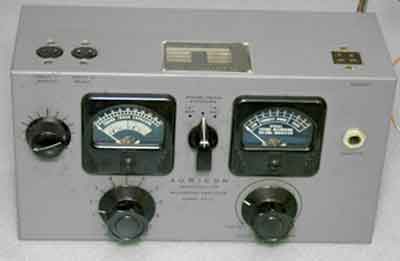 Click here to view a windows media file of all the footage from owyheesound's short film Prospector Pete No.2 This film was shot with the Auricon Pro-600 pictured on this page. The finished short film is silent but location audio was captured to the negative. You can hear the director's instructions to the actors on the optical track.
Click here to view a windows media file of all the footage from owyheesound's short film Prospector Pete No.2 This film was shot with the Auricon Pro-600 pictured on this page. The finished short film is silent but location audio was captured to the negative. You can hear the director's instructions to the actors on the optical track.
Another example of a short roll of film shot using an Auricon-Pro 600 is this film that was shot by Jack Honeycutt, of Portland, Oregon. This short film was shot on some very outdated reversal stock, so the color is a little off, but that only lends to the charm of the vintage 'look' and 'sound' of this great example of a film shot with an Auricon camera. Watch a windows media file of Jack's test by clicking here.
Another example of an optical sound recording done with an Auricon-Pro 600.
The short, 80feet, was shot in May 2005 and is a little over 2 minuts long. While the music was recorded digitally and was mixed in durring post production as were the titles, the actor images and dialogue were recorded with an all original Auricon amp and camera. The digital transfer was done with a 5-blade Telex film chain projector and a JVC gr-d90 (a cheap-o mini-DV camera).
Here is some old info about setting the exposure lamp. Unfortunately it references film stocks no longer available:
7265 - ASA 25 - 16 1/2
7266 - ASA 40 - 16
7256 - ASA 64 - 14
7242 - ASA 125 - 13 1/2
7241 - ASA 160 - 13
Recording sound with an Auricon camera:
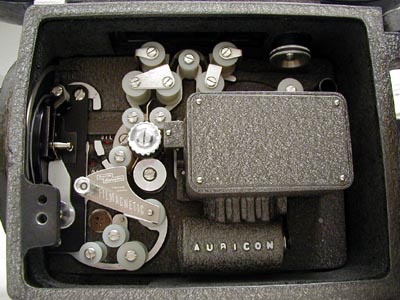 1.) The optical method, which requires a special audio amp to control the exposure lamp in the camera. This is still a viable option. I have actually recorded sound on film on an optical track. It is very cool but not usable for tight edits. It also requires single perf film.
1.) The optical method, which requires a special audio amp to control the exposure lamp in the camera. This is still a viable option. I have actually recorded sound on film on an optical track. It is very cool but not usable for tight edits. It also requires single perf film.
2.) The magnetic method, uses special magnetic striped film. The camera needs to be fitted with a special tape recording head to record sound onto the magnetic stripe on the film while it is being exposed in the camera. Unfortunately, the film is no longer made. Once in a while some unopened rolls from the 80s can be found at old tv station or on ebay but they would not produce a good image even if the developing process was still available. There are a few labs that will develop the film but it is a cross process so it is not so good, even if the film was fresh.
3.) The third way to record sound using two cameras requires two cameras. One acts as the camera and the other acts as a magnetic film sound recorder. When two camera (with AC sync motors like pro-600s) run off of the same inverter, will be in perfect sync. An inverter is a device that changes DCpower from a battery like a car battery or large storage batteries into 120VAC, household power. If one camera is loaded with film and the other camera were loaded with fullcoat mag track (magnetic film) and equipped with the mag recording head then the two will work as a image and sound package. So when you have the film developed you can take the image print and the mag stock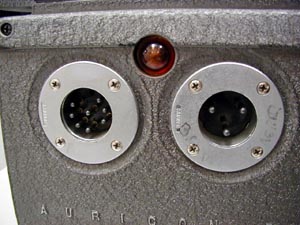 and edit them directly, on a simple synchronizer. There is no need to transfer the audio from the second camera (which is now basically a sound recorder) to mag stock for editing like with a Nagra tape recorder. If you have an interlock projector you can load the developed print and the mag track right away and have a sync sound an image presentation for very little money. This trick came from a guy who at the time was some where in Asia. I am sorry that I lost his email so I can not give him credit until he emails again. So, two small affordable auricons, one with a so called "obsolete" magnetic recording system, is worth a huge pile of production and post production equipment normally used for film production.
and edit them directly, on a simple synchronizer. There is no need to transfer the audio from the second camera (which is now basically a sound recorder) to mag stock for editing like with a Nagra tape recorder. If you have an interlock projector you can load the developed print and the mag track right away and have a sync sound an image presentation for very little money. This trick came from a guy who at the time was some where in Asia. I am sorry that I lost his email so I can not give him credit until he emails again. So, two small affordable auricons, one with a so called "obsolete" magnetic recording system, is worth a huge pile of production and post production equipment normally used for film production.
4.) Traditional dual system of using a tape recorder separate from the camera will work with an auricon. The Auricon AC sync motor is not a precise a a cyrstal sync motor but it is still a very precise system. In the US all household clocks that use 120VAC household power keep time based on the frequency of the power. The AC sync motors in the Auricon work in a similar way. If you are using a modern digital audio recorder like a DAT or a MP3 recorder of some kind you will easily be able to synchronize a telecine of the film image and the digital audio provided you use a slate with clap sticks to synchronize the two devices the old fashioned way. With this method half a minute or more can run in perfect sync without loosing a single frame.
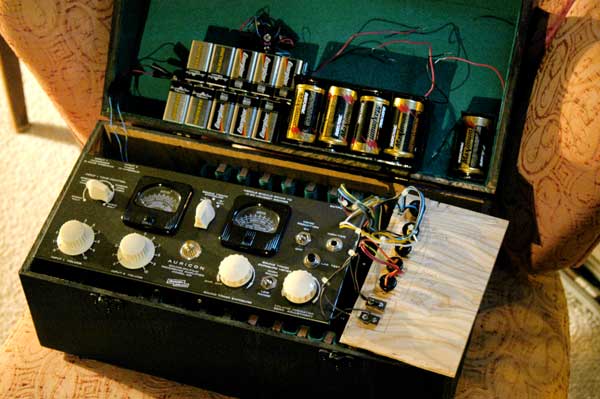
Who Should Use an Auricon?
If you have never shot 16mm motion picture, or even super8mm, before the Auricon is probably not for you. Smaller reflex cameras like the Bolex H16R or the Krasnogorsk K-3 are easy to load, and operate. Especially the K-3 and it is a very affordable camera.
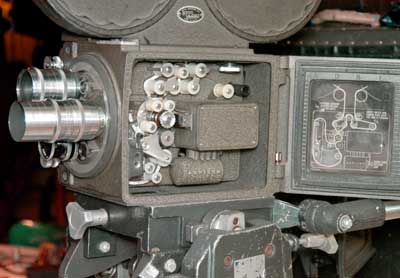 However, if you want to step up to an older fashioned pro camera, and you are patient enough to work with a parallel view finder, and measure the focal distance for every shot then maybe the Auricon is for you. If you want a very affordable way to record sound while making a 16mm film there is no more affordable way than to use an Auricon. The camera are affordable (in the couple to few hundred dollar range) many of the lab fees normally associated with print sound to a final release print are done away with all together.
However, if you want to step up to an older fashioned pro camera, and you are patient enough to work with a parallel view finder, and measure the focal distance for every shot then maybe the Auricon is for you. If you want a very affordable way to record sound while making a 16mm film there is no more affordable way than to use an Auricon. The camera are affordable (in the couple to few hundred dollar range) many of the lab fees normally associated with print sound to a final release print are done away with all together.
The Auricon can also be used just as a regular film camera. If you have looked into using a CP-16 the Auricon is very similar. In fact the CP-16 and CP-16R camera use Auricon parts for there movement. Many CP cameras can be opened up to find "Bach-Auricon" stamped right inside.
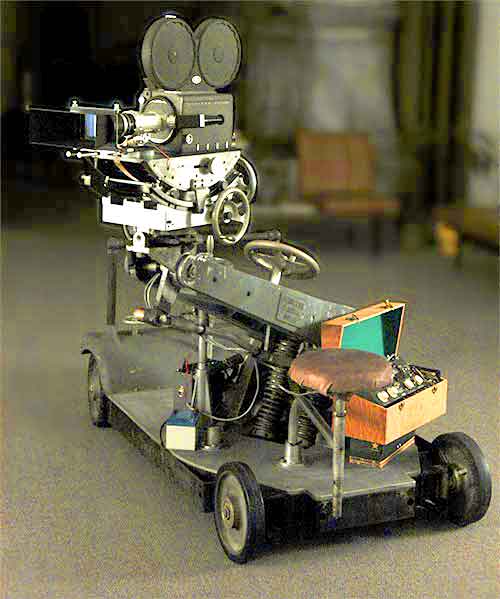 This camera is recommended only for the patient and meticulous. Focus and framing become a conceptual exercise with the camera as it has no reflex viewing (unless you get a lens with a reflex viewer built into). But nearly all cinema up to the late 1960s was done in this way. Every shot has to be focused using a tape measure. And a parallel viewfinder has to be calibrated each time a lens is changed or the focus is changed. These things only take a few seconds but if they are forgotten then the shots may turn out out of focus and misframed.
This camera is recommended only for the patient and meticulous. Focus and framing become a conceptual exercise with the camera as it has no reflex viewing (unless you get a lens with a reflex viewer built into). But nearly all cinema up to the late 1960s was done in this way. Every shot has to be focused using a tape measure. And a parallel viewfinder has to be calibrated each time a lens is changed or the focus is changed. These things only take a few seconds but if they are forgotten then the shots may turn out out of focus and misframed.
The camera is relatively quiet, but not quiet enough to be used in a studio during an intimate scene. The camera will be heard especially if omni direction mics are being used on the sound stage. But in nearly every out door shot, and many indoor shots, especially if a direction mic is being used the camera sound will not be noticeable on the audio recording.
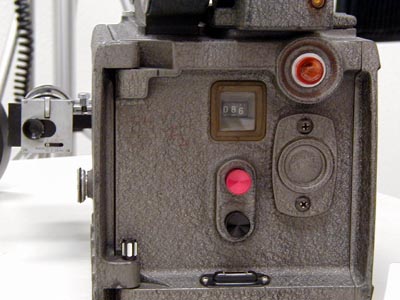 The camera is somewhat heavy so it is not for handheld shots, especially since there is no easy way to balance it over the shoulder. Auricon cameras are to heavy for nearly all still photography tripods and most video tripods. So, some kind of older cinema support must be acquired to properly use the camera. Fearless cradle heads, and ITE TV camera heads are affordable (often less than $100) and they have Mitchell mounts so can be mounted on older wooden or metal Mitchell tripods or any of the many dollies that have Mitchell mounts.
The camera is somewhat heavy so it is not for handheld shots, especially since there is no easy way to balance it over the shoulder. Auricon cameras are to heavy for nearly all still photography tripods and most video tripods. So, some kind of older cinema support must be acquired to properly use the camera. Fearless cradle heads, and ITE TV camera heads are affordable (often less than $100) and they have Mitchell mounts so can be mounted on older wooden or metal Mitchell tripods or any of the many dollies that have Mitchell mounts.
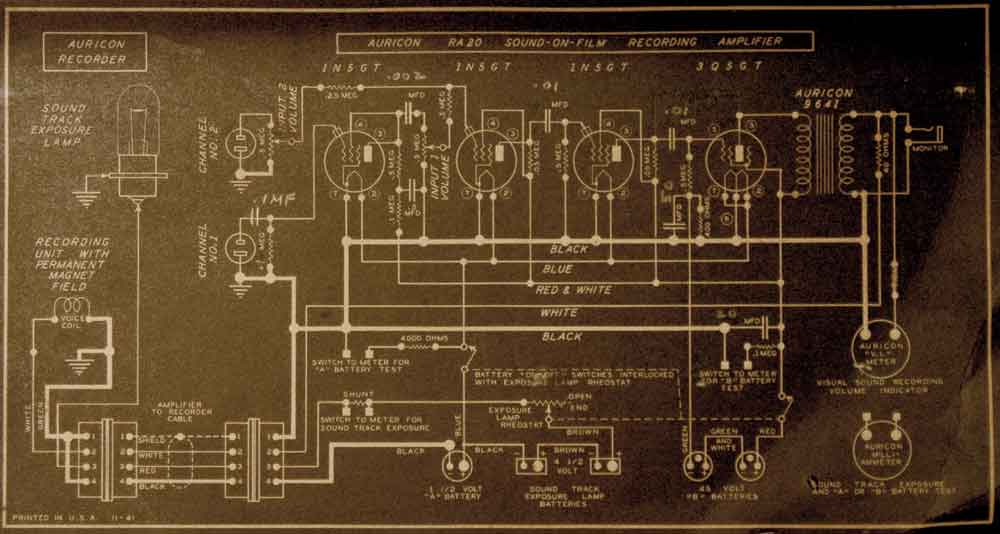 RA-20 pictured above. Save picture to see larger version.
RA-20 pictured above. Save picture to see larger version.
If you are a Auricon enthusiast, or if you have a short film you shot with an Auricon email me. I would love to put any hard to find info up you may have or any examples of clips shot with and Auricon camerahere on this webpage.
Nathan Snyder
nathan@owyheesound.com

 "through the lens" fine focus viewer. It has a reliable movement and 400' magazine. It runs very quiet making it's sound recording options very useable. Originally these cameras were equipped with optical track sound recording, but later the cameras were fitted or retrofitted with magnetic stripe sound recording equipment. Magnetic stripped film is no longer available but the older optical sound option can be used for an interesting effect. The sound quality of an in-camera optical recorder is poor, compared to modern digital standards, but it's unique character has a certain smoothness that is unlike other sound recording mediums. Best of all prints made from camera negatives or reversal stocks can be projected with location sound. If prints are to be made make sure that a super16 aperture and gate are used on the printer, this is necessary to expose the optical track which is at the far edge of the film. Also only single perf films can be used for the negative or the print. Pictured here is an Auricon Pro-600 mounted on a Worrall Geared Head which is in turn mounted on a
"through the lens" fine focus viewer. It has a reliable movement and 400' magazine. It runs very quiet making it's sound recording options very useable. Originally these cameras were equipped with optical track sound recording, but later the cameras were fitted or retrofitted with magnetic stripe sound recording equipment. Magnetic stripped film is no longer available but the older optical sound option can be used for an interesting effect. The sound quality of an in-camera optical recorder is poor, compared to modern digital standards, but it's unique character has a certain smoothness that is unlike other sound recording mediums. Best of all prints made from camera negatives or reversal stocks can be projected with location sound. If prints are to be made make sure that a super16 aperture and gate are used on the printer, this is necessary to expose the optical track which is at the far edge of the film. Also only single perf films can be used for the negative or the print. Pictured here is an Auricon Pro-600 mounted on a Worrall Geared Head which is in turn mounted on a  March 5, 2002 TEST 03.
March 5, 2002 TEST 03.
 RA-20 pictured above. Save picture to see larger version.
RA-20 pictured above. Save picture to see larger version.